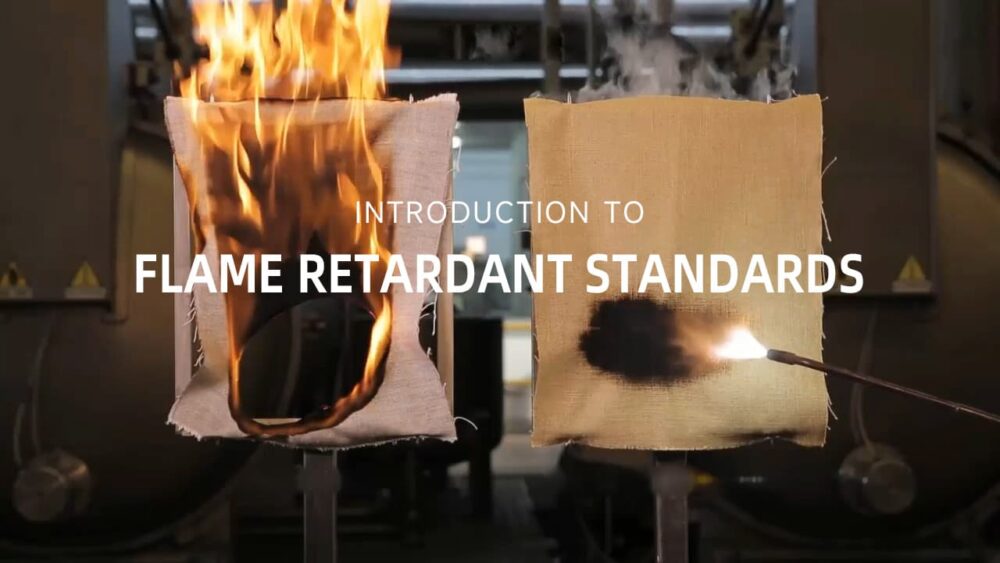O que é tecido retardador de chamas?
Tecido retardador de chama é um tipo de tecido que foi tratado com técnicas de produção especiais para prevenir eficazmente a propagação de chamas. Após o tratamento retardador de chamas, o tecido não queimará quando exposto a uma fonte de fogo. Em vez disso, reduz a inflamabilidade do tecido, retarda a propagação das chamas e evita queimaduras em grande escala. Uma vez removido da chama, o tecido se extingue rapidamente e não continua a queimar ou arder. Também tem boa durabilidade e pode suportar lavagens regulares.
Padrões retardadores de chama nos Estados Unidos
1. CA-117 é um padrão de inflamabilidade amplamente utilizado nos Estados Unidos para têxteis, que não requer um teste de resistência à água e é aplicável à maioria dos têxteis exportados para os Estados Unidos.
2. CS-191 é um padrão geral de inflamabilidade para roupas de proteção nos Estados Unidos, enfatizando a resistência à chama de longo prazo e o conforto durante o uso. A técnica de processamento é tipicamente um método sintético de duas ou múltiplas etapas, que possui alto conteúdo técnico e valor agregado.
3. NFPA-701 e NFPA-703 são normas contra incêndio publicadas pela National Fire Protection Association nos Estados Unidos, aplicáveis a tecidos pendurados, como cortinas, em locais públicos que não exigem resistência à água. Os testes também exigem indicadores físicos e químicos, como umidade adsorvida e toque.
4. TB-603, também conhecido como BHFTI CTB-603, foi implementado em todo o país nos Estados Unidos desde 1º de janeiro de 2005. É usado principalmente em produtos de cama, como colchões. O método de teste envolve a medição do valor de libertação de calor utilizando o método de teste em grande escala num colchão completo.
5. A NFPA 261.94 é aplicável a tecidos resistentes utilizados para estofamento de móveis, incluindo sofás.
6. FAR25-83 é o padrão de resistência ao fogo exigido para tecidos para interiores de aeronaves.
Padrões retardadores de chama da UE
Os padrões de teste de retardadores de chama para roupas de proteção na União Europeia são estabelecidos principalmente pelo Comitê Europeu de Normalização (CEN/TC). Os padrões atuais incluem EN ISO 11611:2007, EN ISO 11612:2008 e EN ISO 14116:2008/AC:2009.
EN ISO 11611:2007 – Roupas de proteção para soldagem e processos similares
O teste é realizado de acordo com a norma ISO 15025:2000, que inclui dois métodos de teste: ignição superficial e ignição vertical. Dependendo do tipo de material, um ou ambos os métodos podem ser selecionados para teste. Para testes de ignição superficial, o material deve atender aos seguintes requisitos:
1. Nenhuma ignição de borda ou ignição superior é permitida para qualquer amostra de teste após a ignição.
2. Nenhuma formação de furo é permitida em qualquer amostra de teste após a ignição.
3. Não são permitidas gotas ardentes ou detritos derretidos em qualquer amostra de teste após a ignição.
4. O tempo médio de pós-chama deve ser menor ou igual a 2 segundos.
5. O tempo médio de pós-luminescência deve ser inferior ou igual a 2 segundos.
A EN ISO 11611 classifica os níveis de segurança dos retardadores de chama em Classe 1 e Classe 2, com as mesmas especificações técnicas para ambos os níveis. O material deve atender aos requisitos especificados para ignição superficial e inferior mencionados acima. A norma EN ISO 11612 alinha-se com os requisitos de desempenho retardador de chama da EN11611, mas não classifica os níveis de segurança.
Padrões retardadores de chama chineses
A China possui padrões retardadores de chamas para roupas de combate a incêndios e soldagem. Esses padrões são emitidos pela AQSIQ e SAC. O padrão para roupas de combate a incêndios é GB 8965.1-2009.
GB 8965-1:2009 – nível B
O teste de retardante de chama é conduzido de acordo com o padrão GB/T 5455-1997, que utiliza o método de teste de chama vertical. O padrão de nível B exige o seguinte:
– Tempo de pós-chama ≤ 2 segundos
– Tempo de pós-luminescência ≤ 2 segundos
– Comprimento do dano ≤ 100mm
– Não são permitidas gotas de fusão.





